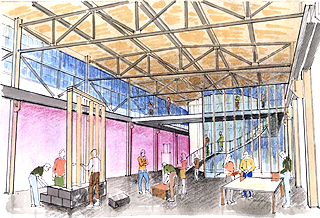
Surveys
Awards
DJC.COM
March 27, 2008
UW builds its construction management program
University of Washington

Schaufelberger
|
After several years of experiencing great demand for its graduates, the University of Washington’s Department of Construction Management will be increasing its enrollment from 100 undergraduate students to 180 starting in September. Since the program has both juniors and seniors, an increase in the number of graduates will not occur until June 2010.
Increasing enrollment has been a goal of the department for several years, but additional faculty resources to accommodate the growth were not available. This year both the governor and the Legislature saw the need for more construction management graduates and provided the needed resources.
The department’s ability to accommodate the additional students is a direct result of the Legislature funding additional student enrollments in high-demand fields. These are professional programs in which additional students would like to enroll and employers need additional employees. Both the Legislature and the governor recognized the need to produce additional construction management graduates to meet industry needs.

Image courtesy of MulvannyG2 Students will get hands-on construction experience in the methods and materials laboratory at UW’s research facility at Sand Point. |
New education facility
To provide an enhanced educational experience for its students, the Department of Construction Management has been developing a hands-on learning and research facility at the former Sand Point Naval Station. The department was able to obtain 28,000 square feet of space in a large 1940-era maintenance and supply building the university acquired when the naval base closed.
The university sought tenants after seismically upgrading the building, installing fire sprinklers and replacing the exterior glazing. Long concerned with the lack of laboratory facilities on campus, the department signed an agreement for the space in 2002 and conducted a design competition among architecture students to identify the best use of the space. Using the students’ ideas as basis, the department faculty developed a program for the space, and MulvannyG2 Architecture was selected to be the designer.
Industry help
A nonprofit foundation was established to raise funds and manage construction of the space. When completed, the facility will be transferred to the university as a gift-in-place. Fundraising began in 2003, with a goal to raise $2 million.
Construction of the project’s first phase began in August 2006 and was completed in March 2007. Construction of the remaining parts of the facility are planned for this year, with classes and research activities to begin in October.
When completed, the Sand Point facility will house two classrooms, a library, five collaborative suites for studio-based courses, offices, a virtual construction laboratory, a methods and materials laboratory, and a media production facility. All funding for the development of this world-class facility comes from industry donors. Foushée and Associates has been the general contractor for all construction.
Virtual construction lab
The virtual construction laboratory will be a place where students can use computer simulation and visualization technologies (like virtual reality) to participate in the construction of different types of structures and learn construction sequencing and safety issues.
Constructability, sequencing, temporary construction, job-site layout, and material storage and handling issues can be explored with simulation models.
Methods and materials lab
The methods and materials laboratory will be a place where students can gain a better understanding of construction concepts, methods, technologies and processes by constructing actual building systems. The hands-on laboratory will also be used to gain an understanding of the factors that affect labor productivity by performing construction activities under different conditions. It will also be used to experiment with construction using various materials.
Construction safety research will be conducted in this laboratory in collaboration with the university’s Department of Environmental and Occupational Health Sciences.
Media production facility
The media production facility will be used to produce construction education media for construction firms and other universities to support their educational programs. The use of this facility is being planned in close collaboration with the university’s College of Education.
Educational benefits
By providing a capability not available on campus, the Sand Point facility will allow the department to significantly enhance its education program and its contributions to the construction industry.
Dr. John Schaufelberger is chair of the Department of Construction Management at the University of Washington.
Other Stories:
- Construction training is good for your bottom line
- How to take over a construction project
- Keep buildings in shape with facility condition indexing
- Top 10 tax tips for contractors and developers
- Is your insurance giving you a bad wrap?
- It pays to have a stormwater permit strategy
- Watch out for changing immigration laws
- Are your windows really Energy Stars?
- The shocking state of our national infrastructure
- Partner up for successful projects
Copyright ©2009 Seattle Daily Journal and DJC.COM.
Comments? Questions? Contact us.